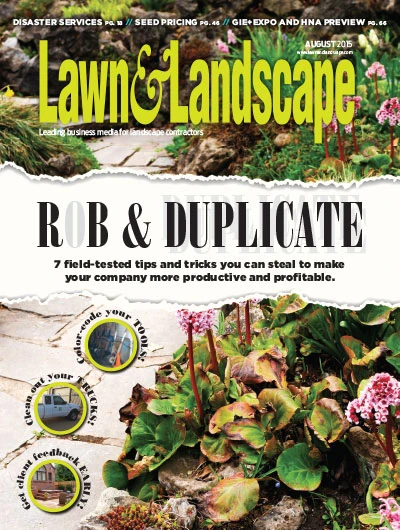
 The weather in Ohio keeps the team at Proscape Lawn & Landscape Services on their toes, and it’s not only due to the threat of a snow storm.
The weather in Ohio keeps the team at Proscape Lawn & Landscape Services on their toes, and it’s not only due to the threat of a snow storm.
“The really challenging part is the transition from fall to winter and winter to spring, because we have to be ready for basically anything,” says Luke Henry, company president. “We’ve got guys out picking up leaves, driving a truck with a salt spreader on the back, pulling a trailer with a vacuum or something. Same thing in the spring.”
The Marion, Ohio-based company was founded in 1998 and added snow and ice removal to its service mix in 2003 to boost revenue, which is almost $2 million, and to attract and maintain a steady workforce. Today about 25 to 30 percent of company revenue comes from winter services, Henry says.
The snow removal season typically runs November through March in ProScape’s area. Add on the time needed to prep, and snow removal takes up almost half the year.
Weather in Ohio is unpredictable, so crews are often prepared to offer green services or snow removal during certain parts of the year, he says.
During the green season, ProScape typically employs about 25 individuals. During the winter, this number increases to 35 to 40. Seasonal employees come from the construction and agriculture industries and others that have winter availability.
“We have some of those folks that work with us almost every time it snows, then we have another subset of people that are like contingent if we have somebody off, someone’s sick, something like that,” he says.
A tailored approach.
Henry says ProScape has an aggressive and personalized approach to snow removal.
|
Fighting snow on social media While it’s difficult to say whether the increasingly robust social media presence at ProScape Lawn & Landscape Services has brought in new clients – it is clear that the presence is helping to support, recognize and encourage snow removal employees on even the most blustery and cold days. This behind-the-scenes social media presence includes photos of employees clearing snow and salting walks. Other times the images and posts show the rewards of their hard work – a pizza party or team-building events. The photos have been incredibly encouraging to crews, says Luke Henry, company president. “The general public doesn’t really understand snow and ice management services, and really, what it takes, how difficult it is and how dangerous it is, really,” he says. “We’re basically out in the very worst conditions, trying to make sure that our clients’ sites are safe.” Henry says his company started consistently using social media about three years ago. Today ProScape uses the platforms Facebook, Instagram and Pinterest. Just recently Henry hired a social media consultant to help manage the presence. The company uses a #snowfighters hashtag, which has gained popularity and use among followers and fans. “It’s us against the weather, and sometimes we feel like we’re winning, and sometimes we feel like we’re losing, but I guess (it’s) just kind of a fun way to mark those pictures that are some of those events,” he says. “That’s our fans’ way of kind of patting our guys on the back and saying thank you.” Henry says social media has allowed him to share a more personal side of his business. “It’s a way to show your customers that you’re a person … (that) there’s goals for your company and good things about your company besides just the work you do,” he says. |
“We tailor the service specifications to the specific client, and then make sure that that’s what we’re delivering. Snow is definitely not a one-size-fits-all type of service,” he says.
Many snow removal clients are pulled from the company’s green season client pool. However, the largest portion comes from multi-family residential, commercial, industrial and retail properties – making up 95 percent of the snow clients when combined. The remaining are single-family residential homes.
For an industrial client, ProScape’s workers may need to know the location of shipping and receiving areas. For a retail client, crews may clear walkways, front sidewalks and handicap parking spots first, he says.
“We may service those areas more frequently, or at least make sure that those are what is getting serviced first when we arrive on the property, tailoring service from the standpoint of making sure that we know when their target times are,” Henry says.
Communicating with clients.
As soon as a client is solicited, a sales representative is assigned. That individual works to understand the client’s needs, previous experiences and any special requests, and prepares a plan and estimate, Henry says.
When the deal closes, this information is passed to an account manager who oversees the actual work being done in the field.
“When we first sign on the client, we put together a sheet with their target time, with projected material usage, with special needs or situations, priorities, and then we build those routes,” he says. “No matter who’s running the piece of equipment, no matter what, we’re ensured that our customers are going to get the right level of service at the right time.”
The account manager is the main point of contact for both client and company, Henry says.
“If there’s additional service that needs provided, or if there’s any questions or concerns that come up, the account manager is both overseeing the crews and they’re working with the client, so there’s nothing lost in translation,” he says.
ProScape also has a written plan of attack for nearly any situation. Routes are customized based on when a business opens on certain days, when employees arrive and shift schedules, he says. For example, on weekends, some businesses may be closed, so service can be delayed until after the open businesses are serviced.
Having these detailed plans is paramount for success when weather is harsh, and crews are tired from running long shifts, Henry says. “Basically in (the snow book), we have all of our routes for different situations – if it snows overnight, if it snows during the day, if it snows on the weekend, and if it snows less than an inch, if it snows 1 to 2 inches, if it snows 2-plus inches,” Henry says.
The author is a freelance writer based in Cleveland.

Explore the August 2015 Issue
Check out more from this issue and find your next story to read.






